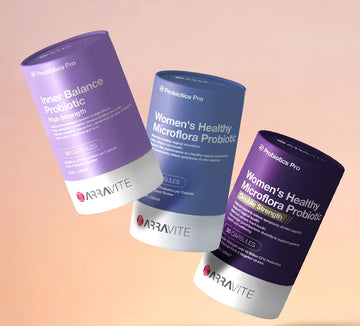Our skin is a micro-forest of thousands of little organisms, which have formed a symbiotic relationship with our body. The beneficial microbiome offers immunity and protection from foreign contamination. However, this beneficial microorganism requires a balanced pH level on your skin to thrive. If your pH is too high, it can pave the way for unwanted bacteria and yeast to grow. If it’s too low, it will kill off the beneficial microbes and thus leave your skin vulnerable to infection and fungi.
Imbalance in vaginal pH can be both uncomfortable and lead to infections, which can affect your overall wellbeing. Therefore, it’s essential to understand how to take care of your vaginal health. Maintaining a stable pH level safeguards your vaginal flora health and provides relief and comfort. Also, adding Healthy Microflora Probiotic supplement ARRAVITE’S, to your daily routine can help ensure correct vaginal pH balance.
What Does Vaginal pH Balance Mean?
What exactly is pH? pH level is like a scale, running from 0 to 14, that tells us if something is acidic or alkaline (the opposite of acidic). A pH score below 7 means something is acidic. A score of 7 is neutral – pure water is a good example. Anything above 7 is alkaline. Your vagina naturally likes to stay acidic. During the age when you can become pregnant, the healthy pH level is usually somewhere between 3.8 and 5. (Source: PubMed)
Why is being acidic so important here? Well, this acidity acts like a natural shield. It creates an environment that unhealthy bacteria and yeast don’t thrive in. At the same time, it helps the “good” bacteria, especially Lactobacillus, to thrive and grow.
Those good bacteria help in defending the harmful bacteria to maintain healthy vaginal health. They do things such as produce lactic acid, which contributes to keeping the vagina acidic (the pH low). It also helps prevent unwanted germs from gaining a foothold. You can think of it as your vagina’s natural defence system.
How to Identify that Your Vaginal pH Is Off?
Sometimes, you might not notice any changes. But your body gives you clear signs when the vaginal pH balance is wrong. Look out for clues like:
- A strong, fishy smell
- Discharge that looks odd – maybe grey, green, or foamy
- Itching around your vagina
- Swelling or soreness
- Pain during sex
- A burning feeling when you pee
These symptoms are likely signs you have an infection such as bacterial vaginosis (BV), trichomoniasis , or a yeast infection. These issues are more likely to arise when your pH level is unbalanced. If you see any of these things, getting help immediately is crucial. It’s a major contributor to vaginal infections prevention and getting appropriate treatment.
Things That May Causes Unbalanced Vaginal pH
There are a few things that can disrupt the natural balance in your vaginal flora health and affect your pH level. Being aware of such things can help you to make healthy dietary choices to help prevent vaginal infections.
- Your Period: Period blood is not an acidic substance, unlike your vagina is typically. So, when you have your period, your natural vaginal pH rises for a little. Keeping tampons in for too long can sometimes disrupt the balance, too.
- Medicines: Antibiotics are powerful medicines that kill bacteria and make you sick. The problem is, they can also kill the beneficial Lactobacillus in your vagina. When these good bacteria disappear, your vaginal pH can elevate. This can make it easier for yeast infections or BV (bacterial vaginosis) to take hold. Some women might also see a change in their vaginal pH with the pill, but it’s different for everyone.
- Douching: That means cleaning inside your vagina, sometimes with special squirty bottles containing fluid that can be scented or a cleaner. Douching disturbs the good bacteria, washes away the vagina’s natural protective layer, causes the pH to shoot up and increases the likelihood of infections. Your vagina is self-cleaning, from the inside out. You only need to gently wash the outer area (your vulva) with plain water or mild, unscented soap.
- Lubricants: Lubes help ease intimacy. But watch out — some lubes have a pH that will be too high for your vagina (it’s higher than 4.5). Using those can kill good bacteria, disrupt the natural balance, and cause irritation or infection. It is ideal to pick water-based lubes explicitly created to mimic the pH level naturally present in a vagina.
- Semen: If semen were acidic, not alkaline (the reverse), then neutral mucous would be chemically perfect to maintain sperm health. So, when you have unprotected sex and semen gets in the vagina, it can temporarily raise the vagina’s pH. In most cases, the vagina returns to normal soon. But if this occurs too frequently, it can become hard for some people to stay balanced. (Source: Wiley Online Library)
- Soaps and Sprays: Powerful soaps, frothy bath liquids, vaginal sprays and deodorants, and scented pads or tampons can harass the sensitive skin of the vagina. They can also upset your natural pH balance. Sticking to gentle, unscented products just for the outside area is best.
How To Maintain Vaginal pH Balance?
Keeping your vaginal pH healthy is easier than you might think. It often comes down to simple, good habits:
1. Eat Well for Vaginal Health
Your diet does impact your good bacteria in your body, which is also super important for your vaginal health. Try eating more:
- It’ll say ‘live cultures’ on the label.
- Kimchi and sauerkraut (These are fermented so they naturally contain good bacteria).
- Fruit and vegetables are good sources of fibre.
- Be sure to drink lots of water daily.
Why does this help? Foods with good bacteria (called probiotics) and foods that feed these good bacteria (called prebiotics) are great for your body’s overall balance, and that includes keeping your vagina healthy. (Healthline confirms that diet impacts your body’s bacteria).
2. Try a Women’s Probiotics
Taking a daily probiotic made just for women can help to keep your vagina balanced. ARRAVITE Women’s Healthy Microflora Probiotics is made with special good bacteria to help fix and support your natural balance.
With ARRAVITE, you get good bacteria that help:
- Keep your vaginal pH steady.
- Protect against harmful germs.
- It enables you to feel healthy and comfortable.
- And it doesn’t have extra fake stuff added in.
3. Don’t Douche Inside
Your vagina cleans itself naturally from the inside. You don’t need special washes or chemicals inside there. Just washing the outside area gently with plain water or mild, unscented soap is all you need to do.
4. Choose the Right Intimate Products
Look for lubes or things for your period (like pads or tampons) that say ‘pH balanced’ on the package. Making this simple choice helps keep your vaginal area healthy and stable. If anything feels off down there, pay attention to it. Catching a small problem early can stop it from becoming a bigger infection.
Why Choose ARRAVITE Probiotics for Vaginal Health?
While diet is the first intervention, probiotic supplements are more helpful for faster results. Particularly if you’re dealing with a pattern of recurrent imbalances or have recently taken antibiotics you may need probiotic supplements to regain your vaginal pH balance.
ARRAVITE’s Women’s Healthy Microflora Probiotics is the perfect solution for rebuilding your natural defences against vaginal infections. It contains six strains of beneficial probiotics that support urinary tract health and maintain healthy vaginal microbiome. It is vegan, non-GMO, dairy and gluten-free. If you are on antibiotics or recovering from an illness, you can try double-strength Microflora Probiotics. It offers double the dosage with every single capsule.
References:
Lin YP, Chen WC, Cheng CM, Shen CJ. Vaginal pH Value for Clinical Diagnosis and Treatment of Common Vaginitis. Diagnostics (Basel). 2021 Oct 27;11(11):1996. doi: 10.3390/diagnostics11111996. PMID: 34829343; PMCID: PMC8618584.
Gallo, Maria F., Warner, Lee, King, Caroline C., Sobel, Jack D., Klein, Robert S., Cu-Uvin, Susan, Rompalo, Anne M., Jamieson, Denise J., Association between Semen Exposure and Incident Bacterial Vaginosis, Infectious Diseases in Obstetrics and Gynecology, 2011, 842652, 10 pages, 2011. https://doi.org/10.1155/2011/842652





